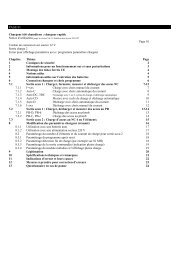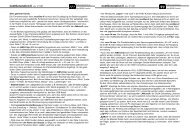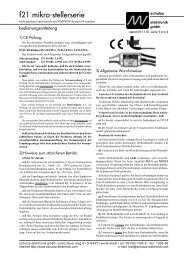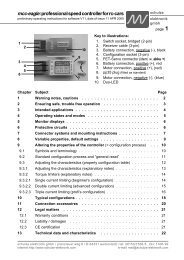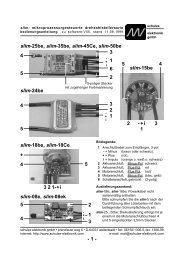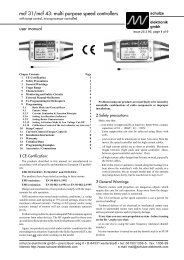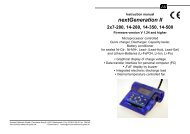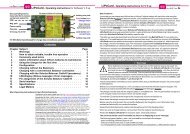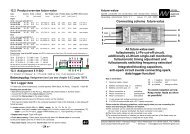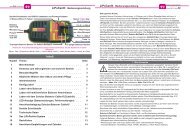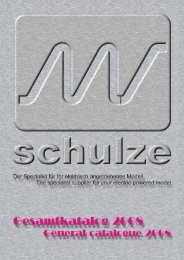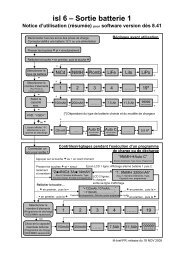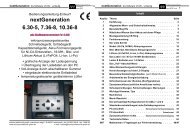ecolader: rapid discharger/charger series - Schulze Elektronik GmbH
ecolader: rapid discharger/charger series - Schulze Elektronik GmbH
ecolader: rapid discharger/charger series - Schulze Elektronik GmbH
Create successful ePaper yourself
Turn your PDF publications into a flip-book with our unique Google optimized e-Paper software.
Page 28 <strong>ecolader</strong>: <strong>rapid</strong> <strong>dis<strong>charger</strong></strong>/<strong>charger</strong> <strong>series</strong><br />
10 Auxiliary sockets<br />
(pins on side of case)<br />
On both sides of the <strong>charger</strong>'s case you will find<br />
a double row of pins for the connection of<br />
auxiliary devices<br />
[*] <strong>ecolader</strong> select only<br />
10.1* Discharge load, left side of case<br />
The discharge load resistance is designed to<br />
allow discharge currents of more than 10 A;<br />
the internal current sink permits a maximum<br />
discharge current of no more than 10 A.<br />
The currents drawn by the external resistance<br />
vary with the voltage of the pack to be discharged.<br />
For this reason the internal discharge<br />
current sink is coupled with the external<br />
resistance for discharging. For example,<br />
it very accurately holds the total discharge<br />
current constant as battery voltage<br />
falls.<br />
The value of the external discharge resistance<br />
has been chosen to ensure that a 6-cell<br />
pack can be discharged at a constant rate<br />
of 20 A until it is completely flat.<br />
Since a fully charged 6-cell battery will<br />
cause a current of just on 20 A to flow<br />
through the external resistance, this represents<br />
the lowest discharge current for 6<br />
cells, even if you set 12 A or 15 A.<br />
The resistance should not be less than 0.40<br />
Ohm / 300 Watts for discharging 6 cells.<br />
The load resistance is always connected in parallel<br />
to the battery to be discharged, provided<br />
that you have set a discharge current<br />
higher than 10 A, and that a discharge program<br />
has been selected.<br />
Caution: standard commercial resistances will<br />
reach a temperature much higher than 100°<br />
C, and this presents a danger of fire or skin<br />
burns, and also of short-circuits if the resistance<br />
features exposed windings. For this<br />
reason use resistances with a case which<br />
prevents skin-contact, and which are either<br />
fitted with a cooling fan or can dissipate excess<br />
heat through a large-area ribbed heatsink<br />
(accessory).<br />
Connections: connect the 10-pin plug to the<br />
pins on the side, and connect the red banana<br />
plug to the positive socket of the akku<br />
1 charge socket (see photo on page 22).<br />
10.2 Flashing light output, left<br />
For connecting a 12 V / 25 W car flasher<br />
bulb to provide visual indication of a full or<br />
discharged battery.<br />
The active flasher output (and the buzzer) is<br />
switched off when you press any of the 9<br />
buttons on the <strong>charger</strong>.<br />
Max. load up to 12 V / 21 W (approx. 2 A).<br />
Circuit-breaker:<br />
The <strong>ecolader</strong> includes an electronic circuitbreaker<br />
which interrupts the lamp current in<br />
an overload situation. To reset the circuitbreaker<br />
disconnect the cable to the flashing<br />
light, and allow the circuit-breaker to cool off.<br />
Remove the cause of the overload before<br />
re-connecting it.<br />
10.3 Fan output, left<br />
For connecting a 12 V battery cooling fan.<br />
The output is polarised.<br />
It is connected permanently to the car battery<br />
supply, i.e. it is not switchable.<br />
Max. load 12 V / 5 W (approx. 0.4 A).<br />
The fan output is connected to the same circuit-breaker<br />
as the flasher output (see Section<br />
9.2).<br />
10.4 Temperature sensor, left (cal on eco+)<br />
For connecting the temperature sensor<br />
(LM335Z) supplied with the <strong>charger</strong>.<br />
10.5* PC socket, left<br />
For connecting to the serial (COM) interface<br />
of a compatible PC via the interface cable<br />
(with 9-pin sub-D connector) supplied.<br />
If your vacant serial port on the PC has a<br />
25-pin socket, use a 9 -> 25-pin mouse<br />
adaptor.<br />
See also Section 10: data interface.<br />
10.6* 8-channel 12-bit A/D converter, right<br />
For selecting individual cells it is important<br />
to obtain accurate voltage information on<br />
each separate cell in a pack when it is discharged<br />
at a high rate, preferably 20 A.<br />
This is possible with the <strong>ecolader</strong> select, as<br />
it provides a means of connecting 8 measurement<br />
wires to factory-assembled packs<br />
(up to 7 cells), and of producing the high<br />
discharge current using an external load resistance.<br />
schulze elektronik gmbh • prenzlauer weg 6 • D-64331 weiterstadt • tel: 06150/1306-5, fax: 1306-99<br />
internet: http://www.schulze-elektronik.com e-mail: mail@schulze-elektronik.com



